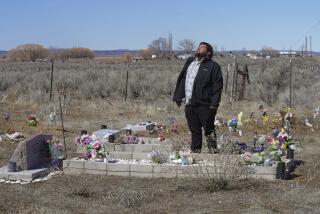Campaign Respectfully Targets Indian Smoking
- Share via
Among the vendors selling rabbit pelts, beadwork and silver jewelry this weekend at the third annual Los Angeles Intertribal Pow Wow, Danielle Glenn-Rivera was putting out the word against tobacco abuse--but not exactly against tobacco.
Glenn-Rivera, a community education worker for the Los Angeles County Health Services Department, has a mission pungent with irony. She warns smokers about the dangers of tobacco, but treats it with a certain respect. Her target audience of Native Americans, an ethnic group with a high rate of tobacco-related illness and death, has used tobacco in religious rites since time immemorial.
“Other people use slogans like ‘stamp out tobacco,’ but we can’t do that,” said Glenn-Rivera, 45, a Panorama City resident of Native American descent and one of four workers in the county’s Health and Faith Program, which reaches minority communities through religious organizations.
Many Native Americans regard the tobacco plant as one of God’s most sacred gifts, yet its leaf has taken a significant toll. A UC San Francisco study of the causes of death among Native Americans statewide from 1986 to 1988 found that 42% of Indian women and 37% of Indian men who died during that period had succumbed to smoking-related illness. By comparison, only 4% of men’s deaths and 8% of women’s were linked to smoking in the state population as a whole.
More exhaustive data on the consequences of tobacco use on American Indians’ health is elusive because surveying methods normally rely on telephone interviews, which are ineffective at reaching Indian households because many lack phones, said Colleen Stevens, a state Department of Health Services spokeswoman.
But smoking clearly is pervasive in Indian communities, public health officials say. Felicia Hodge, director of the Center for American Indian Research and Education at UC Berkeley, said 40% of all American Indians in California--and 50% in urban areas--are smokers, compared to 18.6% of all adults.
What makes this a difficult public health challenge, Glenn-Rivera said, is that so many Indian tribes use tobacco in religious ceremonies, typically burning it in a bowl or pipe, or sprinkling it in a fire as they pray or chant.
“Some tribes,” she said, “have tobacco in their origin stories.”
So on Saturday, at an information table near the entrance of the powwow at the Hansen Dam sports complex, Glenn-Rivera offered plastic rulers decorated with vivid photos of cancerous lungs--but they were stacked under a poster depicting a traditionally dressed Indian whose prayers were wafted to heaven on tobacco smoke.
A day after the announcement of a proposed $368-billion settlement between tobacco companies and a host of plaintiffs, Glenn-Rivera said she was nonetheless fearful that she would have to fight cigarette makers some day on a new front.
“What if they find another way to deliver nicotine?” she asked. “I think the government should regulate nicotine. They’ve found out it is a drug and if it’s a drug, I think they need to regulate it.”
Her message, here and at the dozen or so weekend powwows she attends every year, is that if you smoke habitually, you are abusing tobacco. And if you use it, it’s better to grow your own than to buy commercial brands.
That’s not the message that Glenn-Rivera’s boss, John Schunhoff, the county’s acting director of public health, wants everybody to hear. But it’s an appropriate one for Indians, he said.
“I think you have to tailor your message to the cultural setting in which you provide it,” Schunhoff said. “When you are trying to deal with behavior change, you are not going to be successful unless you deal with the culture.”
The Native American culture that greeted Christopher Columbus was one in which the leaves of a sticky plant were being chewed, sniffed and smoked in a pipe the locals called a toboca, writes Richard Kluger in the book “Ashes to Ashes” (Alfred A. Knopf, New York, 1996).
Columbus returned to Europe with the plant’s seeds and, by the early 17th century, tobacco had spread across Europe and Asia. Commercial tobacco production at the first English colony, Jamestown, Va., proved to be so lucrative that colonial leaders had to take steps to ensure that some farmers were still raising food crops.
*
America grew up, as it were, in a cloud of tobacco smoke. And as the late 20th century’s disclosures amid a growing anti-smoking movement have suggested, the pleasure-giving plant may have been made even more addictive through chemical processing.
Now, working at the powwows, Glenn-Rivera sometimes thinks of her father, a Cherokee Indian from Osage County, Okla., who worked in construction and factory jobs and died of lung and throat cancer.
“Back home, everybody smokes. Dad never stopped. He smoked a couple of packs a day, at least,” she said. She smoked a little too, when she was younger, before she realized what she was doing.
The annual Los Angeles Intertribal Powwow is one of the largest in a city with one of the largest Indian populations of any city in the United States, the Census Bureau reports. The anticipated crowd of nearly 7,000 for the two-day event is more evidence of a widely reported surge in attendance at American Indian gatherings.
“It is growing everywhere--Minnesota, Washington, Nebraska, Florida,” said Les Hand, a Pawnee Indian who, as president of the Golden State Gourd Dance Society, opened the powwow by leading a group of armed forces’ veterans in the stirring Dance of Warriors.
Hand, of Los Angeles, has spent much of his time on the powwow circuit since he retired last year from Southern Pacific Railroad. While crisscrossing the country, he said, he has found many reservations with prospering gaming casinos and young people who, in the wake of cultural touchstones such as the 1990 movie “Dancing With Wolves,” are proud of their heritage.
“More people are going back to the traditional ways,” Hand said.
And traditional ways favor tobacco’s sacred use, said Rose Figueroa, a Blackfoot Apache Indian who works as an exhibition specialist at the Southwest Museum in Los Angeles. Although virtually every American Indian tribe uses tobacco in some way, rituals vary from tribe to tribe and often from clan to clan, she said.
Usually tobacco is mixed with cedar or some other aromatic medium when burned. Sweat ceremonies, a form of group spiritual and physical renewal, usually include tobacco smoking, she said, and women normally join in the rituals and tobacco use.
Figueroa also uses tobacco when she gathers sage from her herb garden, sprinkling it as a gift of thanks to the plant and the Earth for the leaves she is taking. She has also used it to purify her hands when she handles certain artifacts at the museum--an Apache owl-feather cap, for instance, that might be regarded as imparting spiritual harm.
In this form, she said, “there’s absolutely nothing wrong with tobacco in the eyes of the Native Americans.”
In old photographs of traditional tribal gatherings, she said, “you never see pictures of Native Americans smoking cigarettes. . . . It wasn’t abused like it is today.”
More to Read
Sign up for Essential California
The most important California stories and recommendations in your inbox every morning.
You may occasionally receive promotional content from the Los Angeles Times.










